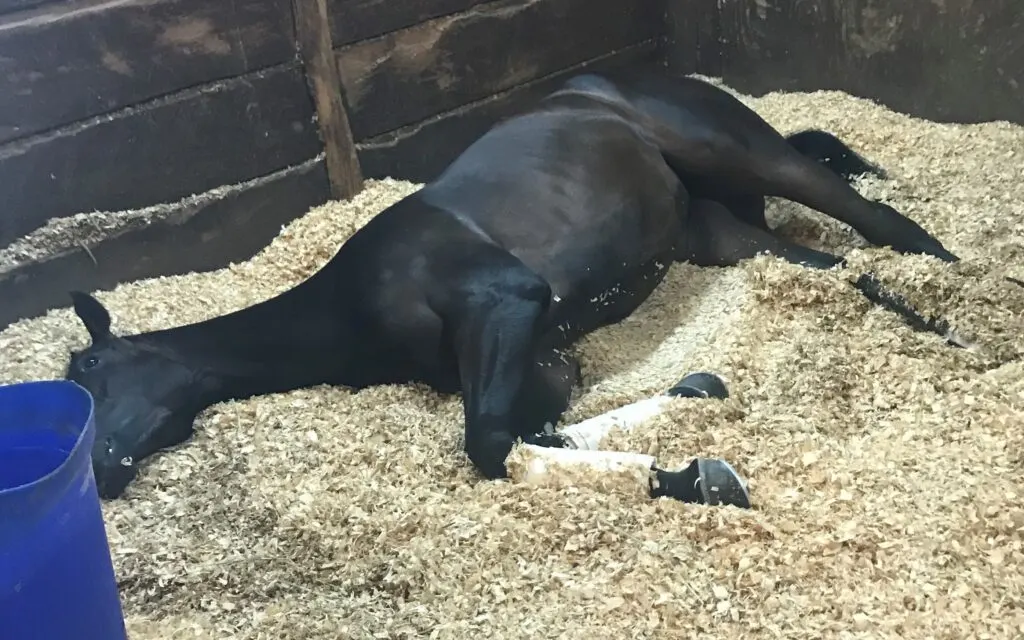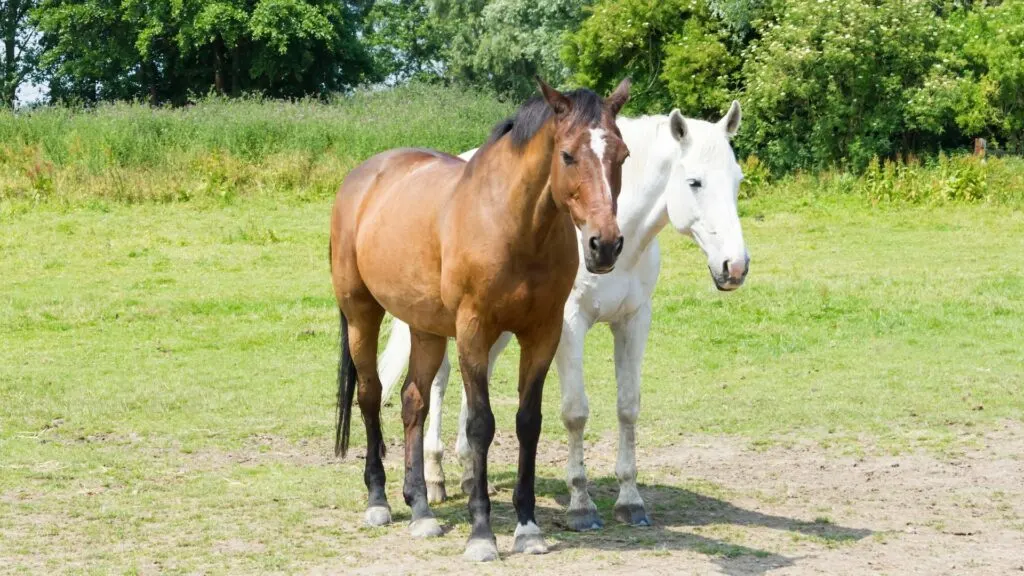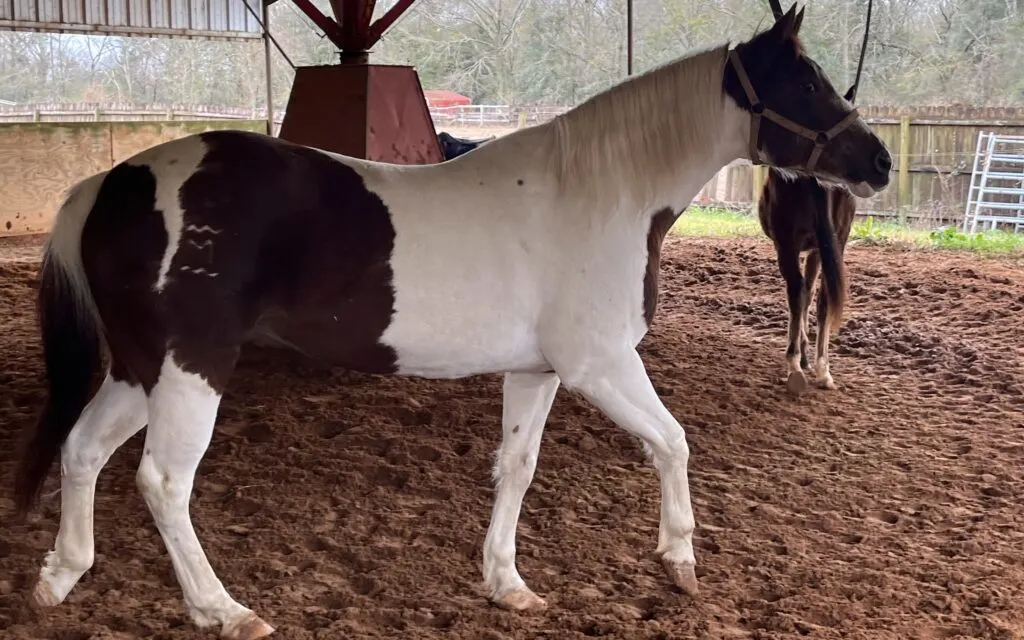Last updated: April 15, 2024
Any links on this page that lead to products on Amazon are affiliate links and I earn a commission if you make a purchase. Thanks in advance – I really appreciate it!
Like us, horses get health issues as they age. Arthritis is one of these issues, making it tough for them to move around comfortably. They might also face other problems like trouble with their teeth, losing their sight, or getting a disease called Cushing’s.
It’s important to catch these problems early. Regular vet visits, knowing what signs to look for, and getting the right treatment can make a big difference. Let’s take a closer look at how we can help them feel better.

Understanding Arthritis in Horses
Arthritis is when a horse’s joints become swollen and painful, making it difficult for them to move. This condition is more common in older horses but can occur in young ones, too. Signs of arthritis include a horse not moving smoothly, appearing stiff after resting, or showing signs of discomfort when moving.
This condition affects more than just a horse’s movement; it impacts their overall well-being. Keeping them comfortable involves managing their pain and ensuring they can move as freely as possible.
Causes and Risk Factors
What causes arthritis in horses? Here are some common factors:
- Breed and Size: Larger breeds, like draft horses, tend to be more susceptible due to the greater strain on their joints.
- Activity Level: Horses that have engaged in high-impact activities or sports are at higher risk as their joints may wear out sooner.
- Injuries: Previous injuries can lead to arthritis later on, even if they seem fully healed.
Knowing these factors can help you prevent arthritis or detect it early, making it easier to manage.

Other Health Problems in Older Horses
As horses get older, they can face several health issues. Let’s look at a few common ones and how to spot them early.
Equine Cushing’s Disease
- What it is: Cushing’s disease is when a horse’s body makes too much of a certain hormone. It can make their coat long and curly and cause them to drink and pee a lot.
- What to watch for: A thick, curly coat that doesn’t change with the seasons and changes in how much they drink and pee.
- How to catch it early: Regular check-ups with your vet can help spot this early and manage it well.
Dental Problems
- What they are: Older horses can lose teeth or wear them down, making it hard for them to eat.
- What to watch for: Trouble eating, dropping food, losing weight, or bad breath.
- How to deal with it: Regular checks by a vet can keep your horse’s teeth healthy and catch problems before they get worse.
Vision and Hearing Loss
- What it is: Older horses might slowly lose sight and hearing, making them jumpy or less aware of their surroundings.
- What to watch for: If your horse gets startled easily or doesn’t respond to sounds and sights like they used to.
- How to help: Keep their living area safe and familiar, and pay close attention to changes so you can adapt to their environment as needed.
All of these issues can really affect how well your horse feels and lives. Keep a close eye on your horse and make sure they see the vet regularly. This way, you can take better care of them as they get older.

Managing Arthritis and Other Conditions
Veterinary Care and Treatment Options
Regular vet check-ups are important to keep your horse healthy, especially as they get older. For arthritis and other similar issues, there are many treatment options.
These include medications to ease pain and swelling, and sometimes surgery for serious cases. There are also other helpful treatments like acupuncture or chiropractic care.
Nutrition and Supplements
What your horse eats plays a big part in managing arthritis and other age-related issues. A well-balanced diet suited to their specific health needs can make a big difference. There are supplements that might help ease arthritis symptoms and support joint health, such as glucosamine or omega-3 fatty acids.
Always consult your vet before starting any new supplements to make sure they’re a good fit for your horse’s specific situation.

Exercise and Physical Therapy
Exercise plays a key role in managing arthritis and keeping your horse moving smoothly. For horses with arthritis or similar conditions, gentle exercises are best. These can include walking or light trotting, which helps maintain strength and flexibility without straining the joints.
Benefits of Physical Therapy
Physical therapy really helps a horse feel and move better. It’s great for easing symptoms and boosting their overall comfort. It helps manage symptoms and enhances overall well-being.
Techniques like hydrotherapy, where horses exercise in water to reduce joint stress, and massage, which improves circulation and muscle relaxation, are very beneficial.

Home and Barn Adjustments
Making small changes to your horse’s living area can make a big difference in their comfort. Ensure their stall has soft bedding to reduce joint stress. Also, keep their living space level and slip-free to help them move around easily.
In addition, there are tools and equipment designed to help horses with arthritis or other age-related issues. For example, rubber mats can ease discomfort when standing, and ramps can help them access different areas without straining their joints.
Examples of Horses with Arthritis: Symptoms and Treatments
Here are some stories about horses with arthritis and how they were helped:
Case Study 1: Daisy
Background:
- Overview: Daisy is a 15-year-old Quarter Horse who began to feel stiff in her back legs after resting, showing signs of difficulty moving and a slight limp.
Diagnosis:
- Condition Identified: The vet diagnosed Daisy with early arthritis in her hocks after a thorough examination.
Treatment Plan:
- Medications: Introduction of non-steroidal anti-inflammatory drugs (NSAIDs) to reduce pain and inflammation.
- Supplements: Incorporation of joint supplements to support cartilage health.
- Exercise Regimen: Customized low-impact exercise routine to maintain joint mobility.
- Hoof Care: Regular maintenance by a farrier to ensure proper hoof balance and support.
Progress and Monitoring:
- Follow-ups: Details on how Daisy’s condition has improved with treatment and what ongoing care looks like.
- Adjustments: Any changes made to the treatment plan based on her progress.
Case Study 2: Thunder
Background:
- Horse Details: Thunder is a 10-year-old Thoroughbred who started having trouble with awkward walking and neck pain, affecting his dressage.
Diagnosis:
- Found Problem: The vet checked Thunder and found he has arthritis in his neck.
Treatment Plan:
- Injections: A vet gave Thunder a few quick shots in his neck to lessen the swelling he did this during a regular vet visit.
- Chiropractic Care: He received regular spine adjustments to help his neck feel better.
- Acupuncture: This treatment was used to help decrease his pain and improve how he feels.
- Exercise Changes: Thunder did special stretches and exercises to help strengthen his muscles and make moving easier.
Results:
- Improvements: Thunder began to move better and had less pain, which let him go back to his dressage training.

Case Study 3: My Experience with an Older Mare
Background: I regularly rode my older mare three to four times a week. Over time, she began showing signs of discomfort, particularly in her right shoulder, which raised my concerns about her health.
Diagnosis: After observing these changes, I consulted our vet who diagnosed her with arthritis. It was a relief to know what we were dealing with, and it helped us make informed decisions about her care.
Treatment Plan: Instead of opting for intensive treatments, we followed the vet’s advice for a simpler approach—increasing her turnout time and reducing riding sessions.
Outcome: This adjustment in her routine brought significant improvements. She is now more comfortable and shows no signs of the pain that was initially troubling her. This experience underscored the importance of adapting care practices to the evolving needs of aging horses.
Takeaway: This personal experience highlights that sometimes, less is more. Simple changes in care and routine can make a profound difference in managing conditions like arthritis.
Here is a YouTube video about riding horses with arthritis
FAQs
How long can a horse live with arthritis?
The life expectancy of a horse with arthritis varies depending on the severity of the condition and how well it is managed. With proper treatment and management strategies, horses with arthritis can live comfortable and active lives for many years.
What are the common signs of equine arthritis?
The common signs of equine arthritis include limping, joint swelling, stiffness, heat in the joint, and behavioral changes. Horses may also have difficulty moving, be reluctant to perform certain activities, or show signs of pain when touched.
What is the best treatment for arthritis in horses?
There is no single “best” treatment for arthritis in horses. Treatment for equine arthritis depends on its type, severity, the horse’s age, health status, and lifestyle. Different treatments may be necessary to manage the condition effectively, with NSAIDs being the most common.
Conclusion
Taking care of a horse with arthritis or other age-related issues is all about recognizing the signs early and giving them the appropriate care. Just like Daisy and Thunder, your horse can lead a more comfortable life with the right treatments and attention.
Take Action Now:
If you suspect your horse might be dealing with arthritis or similar issues, it’s important to act promptly. Discuss with your vet the best care strategies. Also, consider adjusting their diet, exercise routine, and living environment to better support their health.
Share Your Story and Get Help:
Have you managed arthritis or other conditions in your horse? Share your story or how our resources have helped your horse, and join a community dedicated to improving horse health. Please post your tips and stories in the comments or email me at [email protected].
Sign Up for Our Newsletter: Stay updated with the latest tips, stories, and advice on horse care directly in your inbox. Sign up today and never miss an update! Subscribe Here!
Meet Miles Henry
An avid equestrian and seasoned racehorse owner, Miles Henry brings his extensive experience to the equine world, proudly associating with the AQHA, The Jockey Club, and various other equine organizations. Beyond the racetrack, Miles is an accomplished author, having published various books about horses, and is a recognized authority in the field, with his work cited in multiple publications.
🔗 Connect with Miles:
Twitter
Facebook
YouTube: Check out race highlights, horse care tips, and more!

